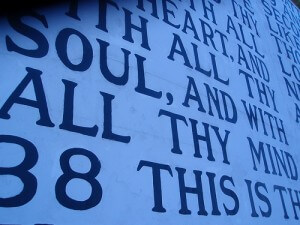Oklahoma Highest Court Says Ten Commandments “Not OK”
September 9th, 2015
There is arguably no constitutional amendment that causes more division among people because of its own provisions than that caused by the First Amendment. As much as one group of individuals looks to the text of the amendment to protect one set of rights, another group seeks the same protection from a different portion of the same amendment. Specifically, the battle that has been waged since the words were first written is between proponents of the right to free speech and religious freedom versus those who seek to ensure that the First Amendment’s promise of no “governmentally established religion” is not eroded.
Oklahoma! Where the….
With all the recent commotion over the Supreme Court’s rulings recently, the commonplace reporting of Oklahoma’s highest court’s ruling about the removal of a Ten Commandments monument is remarkable. This new chapter of a legal struggle that has gone on for years is one that has played out with varying results around the country. Essentially, a 6-foot tall granite monument displaying the Commandments was erected in 2012, and has caused controversy ever since. It is not merely that a monument, which reflects central tenets of Christianity, was constructed and displayed as much as it is the location that was chosen for the display. The structure was placed on the grounds of the Oklahoma capitol building, causing opponents to argue that this placement violated their First Amendment right to not have state-sanctioned religion. Proponents of the monument, on the other hand, argued that the First Amendment protects their right to religious freedom and free speech, stating in earlier battles that the monument depicts something that constitutes “a strong foundation in [their] deeply held religious beliefs.”
A Nation Divided?
What many people reading about the Oklahoma Supreme Court’s decision may not realize is that the Supreme Court of the United States had a similar case in front of it not that long ago. Specifically, in 2005, the Court ruled in favor of the proponents of a Ten Commandments monument outside of the Texas State Capitol. In its ruling, the Court stated that the monument did not violate the Constitution and used a contextual argument to preserve its placement. Essentially the Court stated that the monument, when viewed in a historical context, “conveyed a historic and social meaning rather than an intrusive religious endorsement.”
This begs the question, then, how can the Oklahoma Supreme Court rule the way that it did? Does it not violate every well-known truth about American judicial precedent? It may surprise some to hear that the answer is no. Essentially, Oklahoma’s highest court did not rule that the statute violated the United States Constitution. It ruled that it violated the Oklahoma Constitution; specifically, a little-known provision prohibiting the use of public money to benefit any religious purpose. The Court stated in its opinion that the monument being placed on government property, regardless of the fact that it was paid for by private citizens, violated this provision as it constituted a benefit to one religion over others, albeit an indirect one.
This battle is likely not over, as some Oklahoma politicians have sworn to propose Constitutional amendments that would alter the provision relied on by the Court. As this and other cases move through court systems across the country, Universal Life Church Case Law will continue to monitor them to ensure that all citizens’ freedoms are upheld.


